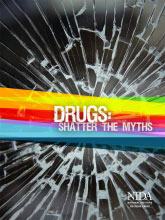The Beat
 Five values. Five weeks of giving. That’s how Volunteers of America Chesapeake, a human services agency whose work stretches from Baltimore, MD, to Virginia Beach, conceives its year-end giving campaign each December. Each week, the campaign focuses on one of VOA Chesapeake’s core values—caring, quality, trust, faith and respect—and highlights the successes of the organization’s many programs and experts, says communication specialist Danielle Milner.
Five values. Five weeks of giving. That’s how Volunteers of America Chesapeake, a human services agency whose work stretches from Baltimore, MD, to Virginia Beach, conceives its year-end giving campaign each December. Each week, the campaign focuses on one of VOA Chesapeake’s core values—caring, quality, trust, faith and respect—and highlights the successes of the organization’s many programs and experts, says communication specialist Danielle Milner.
This past year, the campaign brought in $188,000, nearly two-thirds more than the previous December. Though traditional direct mail and face-to-face marketing played a role, the results wouldn’t have been possible without social media, Milner says. The campaign used Facebook, Twitter, a WordPress blog, YouTube videos, texting, email and the organization’s website to get people interested and convince them to make donations.
“The dynamic of donors is changing,” Milner says, explaining why incorporating social media and mobile technology into the campaign made sense to VOA Chesapeake’s fundraising staff. “They’re becoming younger and they’re becoming more mobile.”
Here are four tips for running a short-term social media fundraising campaign:
1. Simplify your editorial calendar
Choosing weekly and daily themes can make it easier to come up with blog posts, status updates and tweets. In addition to designating each week with one of the five core values, VOA Chesapeake named each day of the week: Motivational Monday, Text Tuesday, Wednesday’s Word, Thank You Thursday and Fun Friday.
Come up with your themes well before the campaign’s launch. That way you can prepare more time-intensive products, like videos, podcasts and staff interviews, ahead of time.
2. Divide the work
A social media fundraising campaign can take up a lot of staff time. VOA Chesapeake divided the work among the five-person fundraising and communication team, assigning each person a day of the week. Even if you don’t have a fundraising or communication department, you can recruit and train social-media savvy volunteers to help out. It’s also a good idea to get influential and inspirational people from your organization to write a few blog posts, status updates or tweets. Milner says some of VOA Chesapeake’s most popular tweets came from their chaplain.
3. More photos, less text
If you have an organizational or personal Facebook page, you may have noticed that photos get more people clicking than other types of posts. “Folks are connected to pictures,” Milner says. “Find pictures that tell a story and show what you’re doing.”
4. Connect your online “channels”
Milner cautions against dumping every bit of information into a newsletter article or status update. Instead, she says, share a photo. Link the photo to a blog post that tells a little bit more of the story. Link the blog post to a Web page where people can read about your program in depth. Spreading information out in that way can turn casual browsers into ambassadors for the cause, she says.
"We want to draw you in,” she says. “Once you’re interested, we want to keep you. And that’s the kind of thing that you tell a friend about.”
More From NCFY
"Right on the Money: Lessons in Social Media Fundraising"
"Right on the Money: 'Crowdfunding' for Youth-Serving Organizations--Indiegogo vs. Kickstarter"
 “Girls Like Us: Fighting for a World Where Girls Are Not for Sale”
“Girls Like Us: Fighting for a World Where Girls Are Not for Sale”
by Rachel Lloyd
In this memoir, a well-known advocate exposes the horrors of sex trafficking, and tells us what it will take to create a society that values and protects girls. NCFY read it, and we tell you why we think it’s a good read for youth workers.
Rachel Lloyd grew up in England with a depressive, alcoholic mother and her series of violent boyfriends. By 14, she had dropped out of school. Faking her age, she did factory work to keep a roof over their heads.
“The pressure to have a baby, at fourteen, already feels intense,” she writes in her memoir “Girls Like Us: Fighting for a World Where Girls Are Not for Sale.” “The desire to create a family, to have someone who will love me, is overwhelming at times. … Having a baby, getting a council flat, working and living and dying here, feels like the most attainable goal.”
Instead, she bought a ticket to Germany, where she wound up broke and desperate. She took a job at a strip club to try to save money for a ticket home. Then she met JP, a former American soldier with a crack addiction. He quickly won her over and then turned violent, routinely beating her and nearly killing her, when she didn’t bring home enough money to feed his habit.
Fighting for a Better World
Lloyd eventually found safety and the support to change her life through a tight-knit, accepting community on a U.S. military base. After moving to New York to be an outreach worker to sexually exploited girls, she founded Girls Educational and Mentoring Services in 1998 to recreate that oasis as best she could.
Lloyd weaves her dramatic but ultimately hopeful story with those of a number of girls she’s helped -- and many she was unable to help -- at GEMS. The result is an examination of how society repeatedly fails and victimizes sexually exploited and trafficked girls, and what these girls need from “the system” as they try to put their lives back together again.
Lloyd writes:
Regardless of the circumstances, what makes the most difference in whether a girl leaves [a life of exploitation] or not when the door opens up is if she believes she has options, resources, somewhere to go, and the support she’ll need once she’s out. Without that glimmer of hope, whether it comes in the form of family, a program like GEMS, or a church community like the one that helped me, it’s unlikely that she’ll leave. And then the door will close just as quickly as it opened, leaving her feeling trapped once more, and this time even more convinced that this is the life she is destined to lead.
Even for youth workers, sex trafficking can seem unimaginable and overwhelming. Lloyd’s book shows that the victimization is real. But the book also argues that solutions to the problem can start in small, manageable doses – a truly safe space, patience, a non-judgmental ear.
More From NCFY
Listen to our podcast interview with Rachel Lloyd about combating sex trafficking.
 As we continue to learn more about the reasons young people may be sexually exploited, some researchers say Native American young women may be particularly at risk.
As we continue to learn more about the reasons young people may be sexually exploited, some researchers say Native American young women may be particularly at risk.
VAWNet, an online resource of the National Resource Center on Domestic Violence, in 2011 reviewed the research on Native women and sex trafficking (PDF, 781KB). The authors of the review point to a 2007 analysis of police records in Hennepin County, MN, which includes Minneapolis. Native women accounted for nearly a quarter of the prostitution arrests that year—a percentage more than 12 times their representation in the county’s population.
The VAWNet report and several other publications over the past few years shed light on how Native women become victims and what might be done to help them recover.
How Sex Traffickers Victimize the Innocent
The VAWNET report looked at research from Minnesota, Alaska and Canada. Exploiters, the report’s authors say, typically recruit Native victims of commercial sexual exploitation in three ways:
- The exploiter poses as a boyfriend or friend, treating the victim with kindness and offering shelter. Then the exploiter coerces the victim to prostitute.
- Gangs or other pimps use violence, including gang rape, to force a woman or girl into prostitution, or they threaten to hurt the victim’s family.
- Traffickers target vulnerable Native women and youth who may be unable to recognize exploitation because of mental illness, substance abuse, or fetal alcohol spectrum disorder.
Compassion and Cultural Sensitivity
Recognizing sex trafficking of Native women as a problem, Minnesota advocates expanded a program for girls with drug and alcohol problems (PDF, 533KB). They aimed to reduce girls’ likelihood of being trafficked. Girls received case management, holistic health care and cultural education and learned to do traditional crafts. Staff educated youth about sex trafficking. They also helped each girl plan where she would go if she was in danger of being targeted by exploiters.
The program’s staff found that simply asking girls if they’d been traded for sex opened the door for them to talk about their experiences—even if they chose not to do so right away.
Similar to Victims of Torture
Victims of sex trafficking, whatever their race or ethnicity, often undergo years of physical, mental and emotional abuse. Like survivors of torture, rape and domestic violence, many sex trafficking victims suffer from PTSD, anxiety attacks and depression, say the authors of a paper on evidence-based mental health treatment (PDF, 121KB) for trafficking victims, published by the Department of Health and Human Services’ Office of the Assistant Secretary for Planning and Evaluation.
The HHS authors found little research on what might help sex trafficking victims deal with their symptoms. But a number of evidence-based therapies, such as cognitive-behavioral therapy and exposure therapy, have been used successfully with similarly victimized people. Those therapies (after a complete psychological exam) are a good place to start when treating sex trafficking victims, the authors write.
Read the Articles
“New Language, Old Problem: Sex Trafficking of American Indian Women and Children” (PDF, 781KB). National Resource Center on Domestic Violence, the National Sexual Violence Resource Center, and the Minnesota Center Against Violence and Abuse (October 2011).
“American Indian Adolescent Girls: Vulnerability to Sex Trafficking, Intervention Strategies” (PDF, 533KB). American Indian and Alaska Native Mental Health Research, Vol. 19, No. 1 (2012).
“Evidence-Based Mental Health Treatment for Victims of Human Trafficking” (PDF, 121KB). U.S. Department of Health and Human Services, Office of the Assistant Secretary for Planning and Evaluation (2010).
(Publications discussed here do not necessarily reflect the views of NCFY, FYSB or the Administration for Children and Families. Go to the NCFY literature database for abstracts of this and other publications.)
 The young woman first contacted Bellefaire JCB, a social service agency in Cleveland, complaining of a toothache. Later, she returned because she’d received a card about the organizations’s trafficking program from the team that responded to her call. Letting her approach the program on her own terms was key to getting her in the door, says Karen McHenry, director of homeless youth and street outreach programs.
The young woman first contacted Bellefaire JCB, a social service agency in Cleveland, complaining of a toothache. Later, she returned because she’d received a card about the organizations’s trafficking program from the team that responded to her call. Letting her approach the program on her own terms was key to getting her in the door, says Karen McHenry, director of homeless youth and street outreach programs.
“Some of the kids aren’t ready to come in,” she says. “We get many calls on our homeless youth hotline every day, but it’s whether the teen feels they can really trust us and that we can help get them to a different situation that matters the most."
McHenry says a young person’s entry into a program is a key opportunity to identify young people who may be sexually exploited. But youth workers have to simultaneously exercise patience and vigilance. Sexual exploitation can be difficult to recognize, especially because most youth don’t see themselves as victims. Staff who recognize the signs of trafficking and know how to respectfully gather information, McHenry says, can better identify sexually exploited youth and direct them to the right services.
“These kids’ pain and these wounds are very much beneath the surface,” she says. “You really need to be skilled in asking the right questions in a very non-threatening way.”
Recognizing the Signs of Trafficking
Enrolling workers in training programs for human trafficking and trauma-informed care can help them sensitively probe for answers that may not come up in a basic assessment of young people’s situation and needs, says Jennifer O’Farrell, director of the anti-human trafficking programs at Operation SafeHouse, a youth shelter in Riverside County, CA.
When staff understand that major events like divorce and death may make teens more vulnerable to trafficking, she says, common intake questions about parental history take on more meaning. Learning about the underlying issues behind trafficking, such as a desire for love and belonging, can also help youth workers understand young people’s reluctance to leave their traffickers.
Other warning signs to look for in a young person:
- Is brought to your facility after being found at a local motel or truck stop.
- Has a cell phone that rings constantly, often showing calls from an unknown number.
- Arrives with large amounts of cash.
- Seems overly distracted or tired.
- Has untended physical or medical needs.
Going Off-Script
Trained staff members can also more easily steer the conversation in a new direction if they sense any signs of human trafficking.
A good example, O’Farrell says, is the question "Do you have any tattoos?" Instead of recording the answer and moving on, youth workers can ask clients about the meaning and history behind their tattoos, which may be a sign of “branding” by a pimp or trafficker.
At Bellefaire JCB, staff members often learn helpful information about a youth’s living situation by asking them if they have a house key. If the youth doesn’t have one, staff members ask what the youth needs to do to be invited inside.
No matter what you ask, always keep the conversation nonjudgemental, O’Farrell and McHenry say.
Of course, learning what youth have been through can take time. Operation SafeHouse staff mark the files of youth who they suspect have been trafficked by placing them in a different colored folder.
Then, when the youth has become more comfortable at the shelter, O’Farrell talks to them one-on-one.
For More Information
The Justice Department’s Office for Victims of Crime Training and Technical Assistance Center has a directory of anti-trafficking training programs.
 Marijuana is addictive. Adults who are hooked on cigarettes most likely started smoking as teens. Getting drunk or high could lead a teen to have unprotected sex. These are just a few facts about drugs that teens may not know.
Marijuana is addictive. Adults who are hooked on cigarettes most likely started smoking as teens. Getting drunk or high could lead a teen to have unprotected sex. These are just a few facts about drugs that teens may not know.
National Drug Facts Week, which will be observed this year from January 28 to February 3, is an opportunity for youth workers to share with teens the truth about drugs and their consequences. The National Institute on Drug Abuse, part of the National Institutes of Health, sponsors the weeklong campaign each year to shatter common myths so teens can make informed decisions. Here are some ways you and your youth can participate:
Chat with NIDA scientists. Drug Facts Chat Day, to be held this year on January 31, is a chance for youth to ask questions of the nation's top experts in the field of drug abuse and addiction. If you and your youth want to ask questions, you’ll need to register in advance. Just make sure to enter your agency’s name where it asks for the participating school name. The live feed and transcript will be made available to everyone online.
Test young people’s knowledge about drugs’ dangers. Invite youth to take the National Drug IQ Challenge. (You might want to take it along with them!)
Share the facts. NIDA’s “Drugs: Shatter the Myths” includes youth-friendly discussions of the ways tobacco, prescription drugs, marijuana and alcohol affect the human body. There’s also information about peer pressure, drugs in songs and movies and the help available for people with drug or drinking problems. Youth can also visit the NIDA for Teens website, which showcases the science behind drug use. The site includes fact sheets, interactive videos and educational games.
 “Using GIS to Enhance Programs Serving Emancipated Youth Leaving Foster Care” (abstract), Evaluation and Program Planning, Vol. 35, No. 1 (2012).
“Using GIS to Enhance Programs Serving Emancipated Youth Leaving Foster Care” (abstract), Evaluation and Program Planning, Vol. 35, No. 1 (2012).
What it’s about: Researchers at the University of South Florida wanted to see if computer mapping could help youth workers find appropriate housing for youth about to live on their own. Using geographic information systems, or GIS, technology to present information visually, the authors identified low-cost, bus-accessible housing options that would support the educational goals and parenting needs of transitioning youth.
Why read it: Many transitional and independent living programs recognize the importance of stable housing for youth transitioning to adulthood. But programs often don't have a uniform method for finding safe and affordable places for youth to live. Government agencies and service providers are increasingly using computer mapping to help solve social problems like this one, and youth workers may be hearing more about this technology in the future.
Biggest takeaways for youth workers: The study found that only a small number of low-rent properties in Florida's Hillsborough County, the area they studied, were suitable for young people once basic safety, educational, transportation and service needs were considered. Youth raising a child were left with even fewer options.
Generally, computer mapping showed promise for helping youth workers find housing options in a large area without pounding the pavement. GIS can also encourage young people to get involved in their own housing decisions because maps can be adjusted based on the youth's feedback, the authors write. In addition, they say, federal, state and local agencies can use mapping to identify areas with a shortage of transition-friendly housing and to work together to address these gaps.
Additional reference: For more information on how mapping can benefit youth workers and tips for getting started, read software provider Esri's white paper about GIS for human and social service organizations (PDF, 370KB).
(Publications discussed here do not necessarily reflect the views of NCFY, FYSB or the Administration for Children and Families. Go to the NCFY literature database for abstracts of this and other publications.)
At the 2012 Pathways to Adulthood conference in New Orleans, NCFY interviewed youth workers from all over the country to get their perspective on two questions: "What's your community doing to fight youth homelessness?" And, "What help do you need to keep fighting youth homelessness?"
Today we're proud to share five of those responses in a new video series. From rural towns to big cities, these are on-the-ground views of the reality of youth homelessness and the best efforts against it. We hope these videos will spur a discussion, so join us on Facebook and Twitter to tell us your own perspective: What is your community doing, and what does your community need to fight youth homelessness?
The series starts with Jeff Allen from Youth and Family Services in Watonga, OK. Watch Jeff's video here.
If you consider your smartphone more of a mini computer than a way to make calls, you’re part of a national trend. Forty-nine percent of all U.S. adults go online using their cell phones, according to research from the Pew Internet & American Life Project. The percentage is probably even higher among young people, according to Nam-ho Park, director of mobile services at digital communications firm Forum One.
“This is a generation that hasn’t lived in an age where they didn’t have cell phones,” Park says. “It’s just a natural part of their lives that they communicate with each other and especially with organizations through mobile technology.”
What does all that mean for you? People who want to learn about your youth-serving organization—whether potential volunteers or donors, local policy makers or young people—may be coming to your website using a phone or tablet computer. So it’s a good idea to think about making your site easy for them to navigate.
Seeing Less, Juggling More
The most obvious challenge for people visiting your website from their cell phones, Park says, is reading text on a smaller screen. Even if you can’t overhaul your site, you can help mobile users by limiting each page to only a few paragraphs. All the important details should fit in the palm of a Web surfer’s hand.
Avoid tiny font, too, because it forces people to zoom into the site with their fingers and makes it more difficult to navigate to another section. Park recommends increasing font sizes and adding more links to reduce this problem. The steps for doing so will vary depending on how you manage your site.
Finally, satisfy mobile users’ need to get information instantly as they juggle multiple activities while surfing the Web.
“You have to really optimize it so that people are getting to the information that they’re looking for on the go, really fast and really easy as well,” Park says.
Email newsletters, if formatted for mobile devices, are a good way to direct mobile traffic straight to helpful pages on your website. Social media updates on Facebook and Twitter can also link people to a specific page you want them to visit.
Learning the Lingo
Whether you pay a tech guru to upgrade your website or you plan to make your own updates, Park recommends learning about a few basic tools for going mobile:
- Themes and plugs ins: Some popular websites and blogging platforms like WordPress and Tumblr offer free “themes” that can be downloaded to make websites look better from cell phones. WordPress also offers plug-ins that can detect when a visitor is using a mobile device and then redirect them to a customized version of the website.
- Responsive design: Responsive design is a tool that recognizes what device a reader is using to access a website and adjusts the size of the Web page accordingly. A potential donor working from a laptop would see three columns about your program, for example, while someone searching with a cell phone would only see one.
- Mobile-friendly “mini” sites: Some organizations choose a handful of the most popular pages from their website to convert into a miniature version of the site.
More Information
Read more of Park’s suggestions for going mobile in an article published by the Nonprofit Technology Network, or NTEN.
 You may have seen the headlines last fall: Researchers from the University of Pennsylvania found that girls with below-average reading ability went on to become teen mothers nearly twice as often as girls with average reading ability. The finding was presented at the American Public Health Association’s annual meeting last year and will be published in the paper “Pre-Teen Literacy and Subsequent Teenage Childbearing in a U.S. Population,” forthcoming in the February 2013 volume of the journal Contraception.
You may have seen the headlines last fall: Researchers from the University of Pennsylvania found that girls with below-average reading ability went on to become teen mothers nearly twice as often as girls with average reading ability. The finding was presented at the American Public Health Association’s annual meeting last year and will be published in the paper “Pre-Teen Literacy and Subsequent Teenage Childbearing in a U.S. Population,” forthcoming in the February 2013 volume of the journal Contraception.
We wanted to know more, especially about what the correlation between low literacy and teen parenthood means for youth workers. So we talked to co-writers Dr. Ian M. Bennett and Dr. Rosemarie Frasso, who studied years’ worth of data from Pennsylvania state databases and the U.S. Census for their paper.
NCFY: What led you to study the connection between literacy and childbirth, and what did you find?
Bennett: Our goal was to bring the perspectives of educators and health care providers together.
Frasso: Public health is a great venue for educators and social workers to look at issues and imagine what the benefits for earlier intervention would be. So while it would be wonderful to read earlier because reading helps you in many different aspects of life and education, another thing you see here is that reading may actually protect them from early childbearing, which leads to other poor outcomes for both the mom and the kid.
Bennett: We looked at a person’s reading skill before they could get pregnant, and then measured their risk basis over seven years, through the rest of their teens. We did the first reading skill assessments at age 11. We found a very strong independent association between their reading skill and their risk of getting pregnant.
NCFY: And why is that?
Bennett: It’s very well shown that kids who have lower reading skills are more likely to drop out of school. Around fourth grade, we make the switch from teaching a kid how to read to needing them to read in order to do the work. “Reading to learn rather than learning to read,” as they say.
So if someone is in fourth grade and they can’t read well, they are being forced every day to come to a setting where they are seen as failures. Choosing to have a child is very much what you would predict for kids who aren’t succeeding in school—seeking a path where they can get out of a context where they have to fail every day.
NCFY: So what are your recommendations for breaking young people out of this cycle?
Bennett: We’ve found that while having one child is risky, what’s worse is having two children or not finishing high school. Those are the two factors that make it much less likely a kid will be independent in their twenties and thirties. So we recommend educators and youth workers do what they can to prevent that second childbirth and keep young people in school.
Frasso: Another important piece is targeting people for interventions. If you know that poor readers are at an increased risk for childbearing in their teens, we want to make sure that information is shared with them about how to postpone childbearing, in a form they can consume. Literacy is going to be a barrier to that information. If we know that about a group, we have to make sure the programs are available to those at greatest risk.
 In our latest podcast, we talk to Dr. Carl Lejuez, a University of Maryland researcher who uses a video game to study why and when people take risks. We asked about his findings and their implications for traumatized youth.
In our latest podcast, we talk to Dr. Carl Lejuez, a University of Maryland researcher who uses a video game to study why and when people take risks. We asked about his findings and their implications for traumatized youth.


 Subscribe to RSS Feed
Subscribe to RSS Feed

 Sign up
Sign up Follow us
Follow us Like us
Like us Sign up for our RSS feeds:
Sign up for our RSS feeds: 

